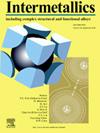Microstructure and wear-resistance of the CoCrFeNiMo high entropy alloy coatings by modulated arc currents using plasma transferred arc weld technique
IF 4.8
2区 材料科学
Q2 CHEMISTRY, PHYSICAL
引用次数: 0
Abstract
High entropy alloys have been regarded as a promising material for wear-resistant coating application. However, the efficient production of high entropy alloy coatings (HEACs) remains an obstacle for their industrial implementation. In this study, the CoCrFeNiMo HEACs with the thickness of ∼4 mm and robust metallurgical bonding were successfully manufactured on the Q345 steel substrate through the plasma transferred arc welding (PTAW) technique. The influence of the varying PTAW arc current (130 A, 180 A, and 230 A) on the microstructure, tribology behavior and wear-resistance of CoCrFeNiMo HEACs was systematically investigated. With the increasing arc current, along with the higher dilution rate, the content of Fe in PTAW-coatings apparently increases from 21.07 at. % (130 A) to 47.60 at. % (180 A), and finally to 55.76 at. % (230 A). The microstructure of PTAW-coatings consists of the primary phase (dendritic region) and the /FCC dual-phases eutectic (inter-dendritic region). However, the primary phase gradually changes from to FCC phase with the increasing PTAW arc current. Nanoindentation test shows that the hardness of σ-phase, σ/FCC eutectics and FCC phase are 19.91 GPa, 10.71 GPa and 5.34 GPa, respectively. The dry sliding friction and wear tests indicate the improved wear-resistance as the PTAW arc current decreases from 230 A to 130 A. The coefficient of friction (COF) decreases from 0.75 to 0.64, the average hardness increases from 316 HV to 661 HV, and the wear rate reduces from 5.65 10−4 mm3 Nm−1 to 2.42 10−4 mm3 Nm−1. Meanwhile, the wear mechanism gradually changes from a combination of adhesive wear, oxidative wear and abrasive wear to the dominant abrasive wear due to the changed constituent phases.
利用等离子体转移电弧焊接技术通过调制电弧电流焊接 CoCrFeNiMo 高熵合金镀层的微观结构和耐磨性
高熵合金一直被认为是一种很有前景的耐磨涂层材料。然而,高熵合金涂层(HEACs)的高效生产仍然是其工业化应用的障碍。在本研究中,通过等离子体转移电弧焊(PTAW)技术,在 Q345 钢基体上成功制造了厚度为 ∼4 mm、冶金结合牢固的 CoCrFeNiMo HEACs。系统研究了不同的 PTAW 电弧电流(130 A、180 A 和 230 A)对 CoCrFeNiMo HEACs 的微观结构、摩擦学行为和耐磨性的影响。随着电弧电流的增加和稀释率的提高,PTAW 涂层中的铁含量明显从 21.07 at.%(130 安培)增加到 47.60 安培(180 安培),最后增加到 55.76 安培(230 安培)。% (230 A).PTAW 涂层的微观结构由主相(树枝状区域)和 σ/FCC 双相共晶体(树枝状区域之间)组成。然而,随着 PTAW 电弧电流的增加,原生相逐渐从 σ 转变为 FCC 相。纳米压痕测试表明,σ 相、σ/FCC 共晶和 FCC 相的硬度分别为 19.91 GPa、10.71 GPa 和 5.34 GPa。干滑动摩擦和磨损试验表明,随着 PTAW 电弧电流从 230 A 减小到 130 A,耐磨性得到改善。摩擦系数(COF)从 0.75 减小到 0.64,平均硬度从 316 HV 增加到 661 HV,磨损率从 5.65 × 10-4 mm3 ∙ Nm-1 减小到 2.42 × 10-4 mm3 ∙ Nm-1。同时,由于成分相的变化,磨损机理也从粘着磨损、氧化磨损和磨料磨损相结合逐渐转变为以磨料磨损为主。
本文章由计算机程序翻译,如有差异,请以英文原文为准。
求助全文
约1分钟内获得全文
求助全文
来源期刊

Intermetallics
工程技术-材料科学:综合
CiteScore
7.80
自引率
9.10%
发文量
291
审稿时长
37 days
期刊介绍:
This journal is a platform for publishing innovative research and overviews for advancing our understanding of the structure, property, and functionality of complex metallic alloys, including intermetallics, metallic glasses, and high entropy alloys.
The journal reports the science and engineering of metallic materials in the following aspects:
Theories and experiments which address the relationship between property and structure in all length scales.
Physical modeling and numerical simulations which provide a comprehensive understanding of experimental observations.
Stimulated methodologies to characterize the structure and chemistry of materials that correlate the properties.
Technological applications resulting from the understanding of property-structure relationship in materials.
Novel and cutting-edge results warranting rapid communication.
The journal also publishes special issues on selected topics and overviews by invitation only.
 求助内容:
求助内容: 应助结果提醒方式:
应助结果提醒方式:


